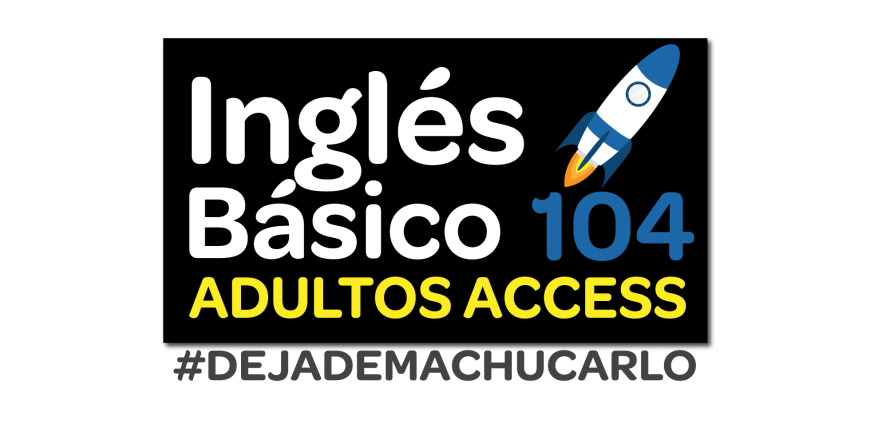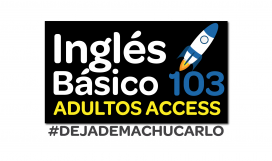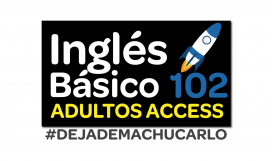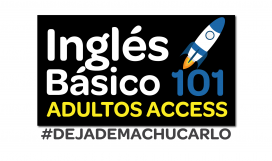Inglés Básico Adultos Access 104

El Inglés Básico Adultos Access 104 es un programa diseñado para mayores de 17 años. Es el último nivel básico de nuestro programa (como requisito debe haber completado el nivel 103 o tomar examen de nivel). Este combina los elementos fundamentales del idioma de forma puntual de modo que el estudiante sea capaz de utilizar el vocablo de inmediato. A partir de este momento, todo el contenido disponible será en inglés pues estaremos utilizando la metodología de aula invertida y el método comunicativo.
La metodología de aula invertida o Flipped classroom es la concepción de que el alumno puede obtener información en un tiempo y lugar que no requiere la presencia física del profesor. Se trata de un nuevo modelo pedagógico que ofrece un enfoque integral para incrementar el compromiso y la implicación del alumno en la enseñanza, haciendo que forme parte de su creación, permitiendo al profesor dar un tratamiento más individualizado. Por consiguiente, usted verá el contenido antes de su encuentro con el profesor.
Ventajas de esta metodología:
- Usted es el protagonista
- Uso de tecnología y plataformas web
- Consolida el conocimiento
- Favorece la diversidad en el aula
- Aprendizaje más profundo y perdurable en el tiempo
- Mejora el desarrollo de las competencias por el trabajo individual y colaborativo
Esto permite que los encuentros sean más enfocados en la parte oral, haciendo uso del método comunicativo o CLT, que es un enfoque en la enseñanza de idiomas donde se prioriza la interacción oral del lenguaje.
Bienvenido al mundo bilingüe!
B1 Lesson 5A
These are the objectives of lesson 5A, which include topics such as: family relationships, the use of present continuous and simple present.
In this lesson you are going to need to watch a video that teaches you the different members of the family.
In this lesson you are going to have to watch a video that shows you the different family members vocabulary and then answer questions.
In this lesson you are going to need to speak the words using your microphone to practice your pronunciation.
In this lesson you are going to watch a video that shows you some useful phrases and questions to talk and ask about someoe's family.
In this lesson you are going to study a group of cards with some phrases you can use to talk about your family and to ask others about theirs.
In this lesson you are going to listen to someone talking about his family and then answer the questions below.
In this lesson you are going to watch a video that teaches you how to make questions using the present continuous tense.
In this lesson you are going to complete the questions in the video choosing the correct answers.
In this lesson you are going to watch a video that teaches you the differences between simple present and present continuous.
In this lesson you are going to complete the sentences using the simple present or the present continuous when corresponding.
In this lesson you are going to select the gramatically correct sentences according to the usage of the tense (simple present or present continuous).
B1 Lesson 5B
These are the objectives of lesson 5B, which includes topics such as: quantifiers and how to use them to state facts.
In this lesson you are going to watch a video that teaches you different quantifiers and how to use them.
In this lesson you are going to watch a video that teaches you how to use the quantifiers properly.
In this lesson you are going to choose the correct quantifier option to complete the sentences in the video.
In this lesson you are going to read a text of different people describing the amount of time they spend with their families respectively.
In this lesson you are going to choose the correct quantifier to complete the sentences.
In this lesson you are going to drag the correct quantifiers to the boxes to complete the sentences.
This a quiz to test your knowledge on lessons 5A and 5B.
B1 Lesson 6A
These are the objectives of lesson 6A, which include topics such as: fitness habits and exercise, collocations and frequency of free-time activities engaging.
In this lesson you are going to study a set of dialog cards which gives you information about some sports and fitness activities.
In this activity you are going to guess the name of the sports and activities shown in a set of flashcards.
In this activity you are going to watch a video that shows you how to formulate ideas and statements about your interests and hobbies and the frequency one engages in them.
In this lesson you are going to watch a video that shows you how to use the adverbs of frequency and the formula to make sentences correctly.
In this activity you are going to complete the conversation dragging the correct questions to the answers.
In this lesson you are going to watch a video that shows you how to have a conversation about exercise and fitness habits.
B1 Lesson 6B
These are the objectives of lesson 6b, which include topics such as how to ask and answer questions with how and to talk about exercise.
In this activity you are going to watch a video that shows you how to make questions with 'how' and the use of each one.
In this activity you are going to choose the correct options to answer the 'how' questions.
In this activity you are going to complete a group of questions by dragging the correct phrases.
In this activity you are going to Listen to these conversation about exercise and fitness and answer the questions below.
In this activity you are going to study a group of cards with some information on different terms related to fitness and sports.
In this activity you are going to read a text about team sports and then answer some reading comprehension questions.
This is a quiz to assess your knowledge on lessons 6A and 6B.
B1 Lesson 7A
These are the objectives of unit 7A, which include topics such as: the use of simple past to talk about past events and vacations.
In this activity you are going to watch a video that teaches you how to congugate sentences in the simple past tense.
In this activity you are going watch a video and complete the sentences using the correct form of the simple past within.
In this activity there's a short video you will need to watch with an explanation on how to form questions in the simple past tense.
In this activity you are going watch a video and complete the sentences using the correct form of the simple past within.
In this activity you are going to watch a video that shows you a group of the 50 most common irregulat past tense verbs you should know and memorize.
In this activity you are going to write a group of irregular verbs in the base form based on the simple past form shown.
In this activity you are going to drag the correct words or phrases to match the answers presented in the exercise.
In this activity you are going to study a group of vocabulary cards that teach you different collocations with make, do, take, etc.
B1 Lesson 7B
In this activity you are going Watch the video and complete the sentences using the correct form of the verb in the simple past.
In this activity you are going to listen to different people talk about their last summer vacations and then answer the questions.
In this activity you are going to read a text and mark the verbs in the simple past tense and also complete an exercise after reading.
In this activity you will have to answer the questions using the simple past form of the verb "Be" in the correct way for each sentence.
In this activity you will have to answer constructing the correct simple past for the following questions, to learn how to give short questions and answers.
In this activity you will have to complete the sentences using the simple past of the verb "Be" about past vacations.
This is a simple quiz about lesson 7 A and B, so the students will be able to test their knowledge about what they learned in the unit.
B1 Lesson 8A
These are the unit objectives, that include topics such as, places on the neighborhood, how to describe them, ask and give directions and more.
In this activity you will have to watch the video to learn the proper use of "there is" and "there are", to use it to describe things and places.
In this activity you will have to complete the spaces with the correct choice for the use of "there is" or "there are".
In this activity you will have to watch the video to learn about the correct way of using "Any" and "Some", to use in conversations.
In this activity you will have to watch the video and learn about the prepositions of places used to give and ask for directions.
In this activity you will have to watch the video to learn about some adjectives used to describe places.
In this activity you will have to read and learn about places that you go and what you do in the neighborhood, to expand your vocabulary.
In this activity you will have to fill the blanks with the correct answer about what do you do in the places of your neighborhood.
B1 Lesson 8B
These are the objectives from the unit 8B, which include topics such as, quantifiers to describe neighborhoods, places and more.
In this activity you will watch the video of the grammar to use quantifiers in English, the rules and proper applications of them.
In this lesson you will have to mark the quantifiers in the text, to understand how they can be used in sentences and conversations.
In this activity you will have to watch the video to learn how to describe a neighborhood and the places that neighborhoods have.
In this activity you will have to watch a video to learn the grammar of using "how much and how many", as quantifier questions to describe.
In this activity you will have to fill the blank spaces with "how much or how many", accordingly, to understand how to use them.
In this activity you will have to read through the texts and answer the questions specified below with the information from the texts.
This is a short and simple test about the content in unit 8 (part A and B), that way the students can prove what they learned.
B1 Lesson 9A
These are Lesson 9A objectives, that include topic such as: describing, listening and asking/answering about physical appearance and characteristics.
In this activity you will have to watch a video to learn how to use adjectives and phrases to describe people's physical appearance and characteristics.
In this activity you will have to watch the video to learn words and phrases used to describe people's physical appearances and characteristics.
In this activity you will have to read the cards front and back to learn adjectives and phrases to describe physical appearance.
In this activity you will have to look at the picture and describe their physical appearance, based on the question asked.
In this activity you will have to say the word to your mic, in order to learn how to properly pronounce the adjectives of physical appearance.
In this activity you will have to listen to the video and correctly answer the question below about the video.
In this activity you will have to fill the crossword using the words that you have learned from the vocabulary.
In this activity you will have to read the answers, and complete with the correct questions in the blank space.
B1 Lesson 9B
In this activity you will have to watch the video to learn about clothing items that people normally use, and add them to your vocabulary.
In this activity you will have to read the front and the back of the cards, to learn about some popular and different clothing styles.
In this activity you will have to answer the question about the clothing styles in order to learn how to identify them and describe them.
In this activity you will have to click and select from the text, all the clothing styles that you can find.
In this activity you will have to watch the video to learn the grammar and uses of modifiers with prepositions and participle to describe people's clothing.
In this activity you will have to answer the questions with the correct choice, questions about modifiers, participles and prepositions.
B1 Lesson 10A
In this activity you will learn how to properly and grammatically use the present perfect tense to use in conversations.
In this activity you will learn how to ask and answer questions related to activities, using "have you ever" and "would you like to" in conversations.
In this activity you will learn how to use "yet - already - still - just" in conversations about activities that you want to do or already did in the past.
In this activity you will have to fill in the blank spaces with the correct present perfect form for the verbs given.
In this activity you will have to fill the blank spaces with the correct questions using "have you ever" (first exercise) and "would you like" (second exercise), using the tips given.
In this activity you will learn the different uses for "yet - still - already - just", by selecting the correct answer given in the exercise.
B1 Lesson 10B
These are the lesson 10B objectives, which include topic such as: Present perfect, simple past, time expressions and more.
In this activity you will have to watch the video to learn how to differentiate Present Perfect tense and simple past tense, their uses and applications.
In this activity you will have to watch the video to learn the differences between FOR and SINCE, their uses and applications.
In this activity you will have to watch the video and learn how to use present perfect and simple past in conversations about past activities.
In this activity you will have to watch the video to learn the different time expressions used in the present perfect tense.
In this activity you will have to fill the blank spaces with SINCE or FOR, to complete the correct sentence.
In this activity you will have to select the correct answer to complete the sentence, using the time expressions in present perfect.
B1 Lesson 11A
In this activity you will have to watch the videos to learn what are and the uses of adjectives, adverbs and conjunctions, and use them to describe.
In this activity you will have to watch the video and listen to the conversation, to complete the exercise about adjectives that will be below the video.
In this lesson you should complete the crossword with the adverbs of the words inside the parenthesis to complete each sentence.
In this lesson you will have to watch the video and listen the way the characters describe their hometown/city and learn how to describe them too.
In this activity you will have to fill the blank spaces using "HAS" or "IS" , to complete the city description in the exercise.




